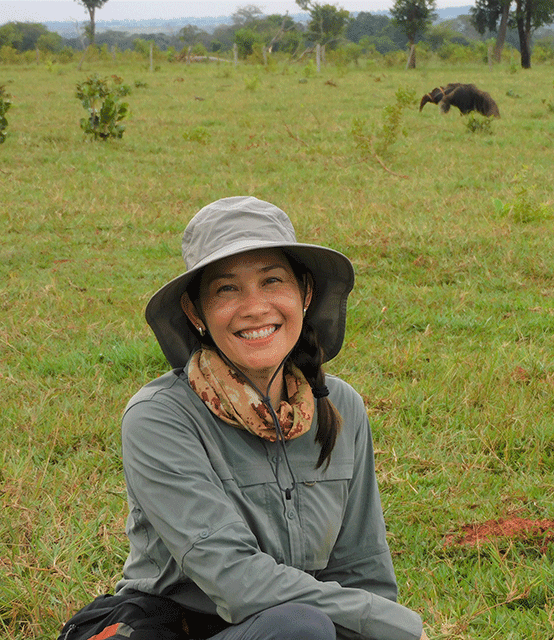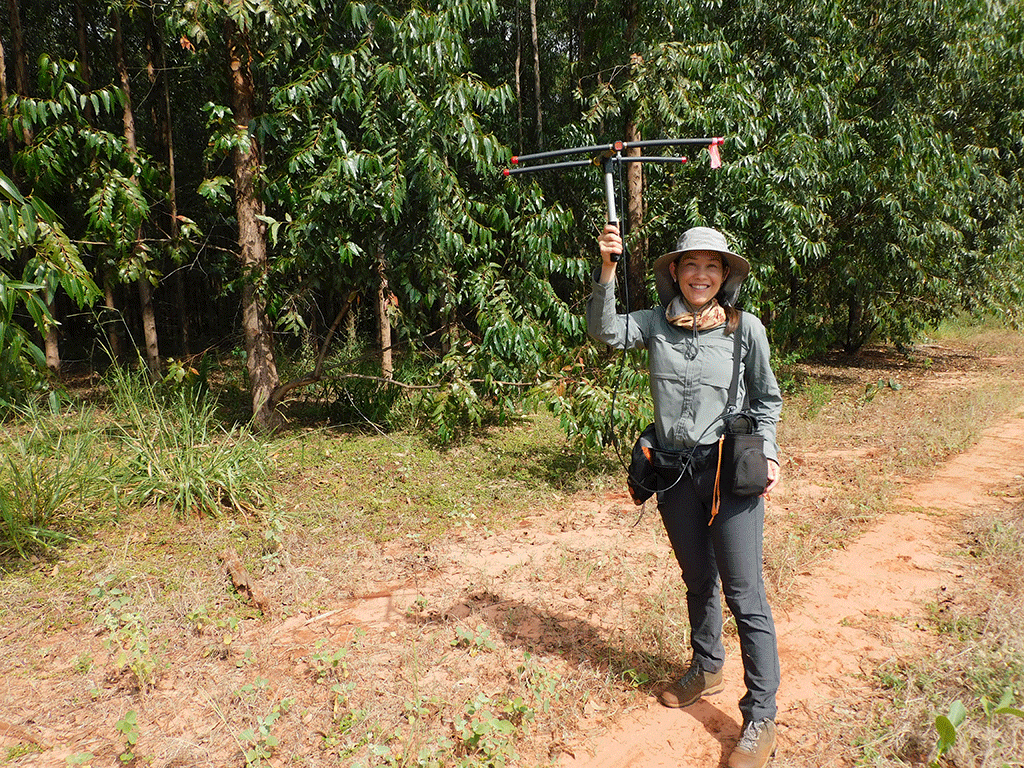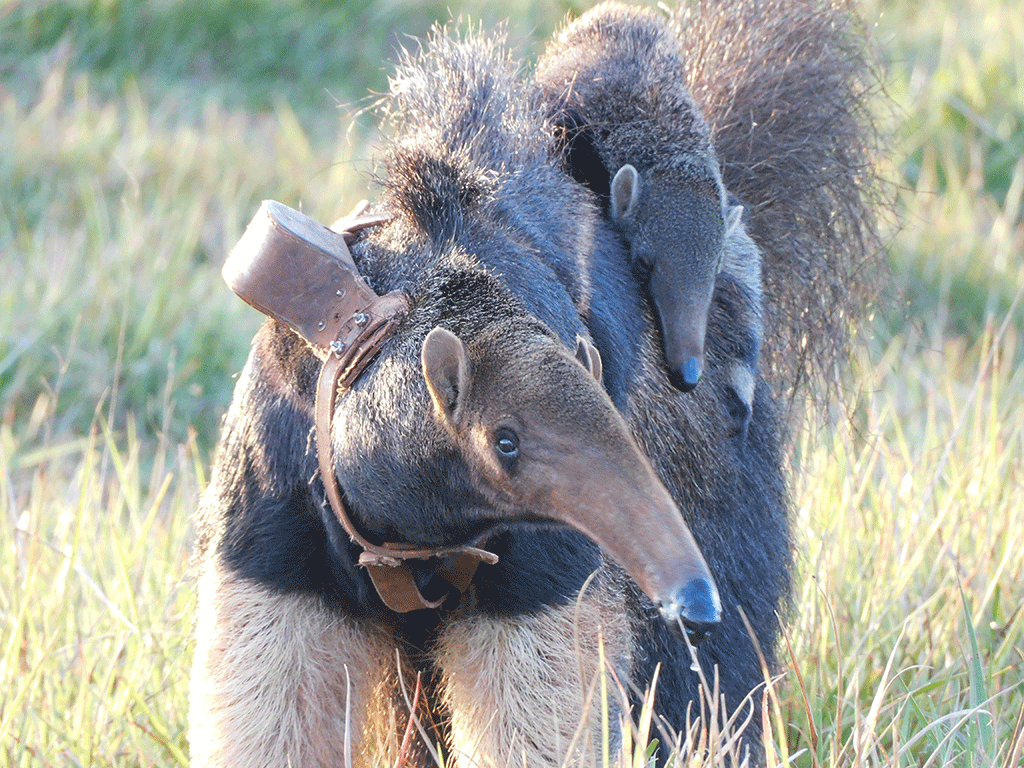
Watching giant anteaters eat, sleep, play and give piggyback rides to their pups was part of this summer’s fieldwork for Ana Yoko Ykeuti Meiga, a PhD student in SNRE’s Interdisciplinary Ecology program. Ana accompanied a team of researchers from a regional NGO to survey giant anteaters in the Brazilian Cerrado, a vast tropical savanna that is facing threats from large-scale agriculture and climate change. Her dissertation research examines how regional land uses in the Cerrado, such as Eucalyptus and soybean production, affect giant anteater behavior.
Ana’s summer field research was partially funded by a UF Tropical Conservation and Development (TCD) Research Grant. She was also recently awarded a travel grant from The Wildlife Society to attend the Society’s 30th Annual Conference in Louisville, Kentucky this coming November, and present findings from her research.
In April, Ana was one of four graduate students who won a “Best Poster” award at SNRE’s 2023 Research Symposium. Her poster covered her research on how landscape characteristics influence giant anteaters’ movement behavior.
We talked to Ana about her fieldwork and her progress through her degree program, and what she plans to do after school.
First tell us a little about giant anteaters. What do you think everyone should know about them? And what threats are they facing in the Brazilian Cerrado?
The giant anteater (Myrmecophaga tridactyla) is a large-bodied mammal, with its weight varying from 31-45 kg. It is the largest anteater species, reaching out 1.8-2.4 meters from the tip of its snout to the end of its tail. They have fascinating and unique looks, characterized by their elongated head, small toothless mouths, and bushy tails. They have a long and sticky tongue, between 35 and 40 cm, used to ingest thousands of ants and termites per day. Giant anteaters have a single offspring born after a pregnancy of around 6 months. Mothers carry their offspring on their backs for several months. And for me, they are one of the most beautiful animals in the world.
The giant anteater is listed as “vulnerable” under the IUCN Red List of Threatened Species. The population of giant anteaters has decreased over time, and this is attributed to a variety of factors such as landscape fragmentation, habitat loss, poaching, dog conflicts, roadkill, and wildfires. In the Brazilian Cerrado, deforestation has occurred rapidly, with more than half of the biome converted into pasture or farmland. This has resulted in the fragmentation of habitats and an increase in roadkill fatalities for giant anteaters.

What methods and tools did you use to carry out your field research?
I am lucky to have my Ph.D. project in partnership with the Wild Animal Conservation Institute (ICAS), an NGO created to support conservation projects (www.icasconservation.org.br). ICAS founder Dr. Arnaud Desbiez and his team focus on projects for the conservation of endangered giant armadillos and giant anteaters. ICAS team has distinguished scientists, and I was able to follow and learn from them. During my field research, I followed Dr. Alessandra Bertassoni, tracking giant anteater females with pups, to observe their behavior. We used the device Global Position System (GPS) signal to find the animals and start the direct observations. These observations took place five to ten meters’ distance from the animals to avoid human interference. I also followed the veterinarian’s team (Mario Alves and Dr. Grazielle Soresini), and we spent the days driving on top of the truck, making direct observations, and searching for giant anteaters. We also used the GPS to find the anteaters and inspect the health conditions of the animals and the harness situations. I could observe the veterinarians capturing and changing the anteaters’ harnesses.
Because my research focuses on land use and land cover change, it was very important for me to visit the study sites and understand the areas where the giant anteaters are being monitored. We used drone imagery so I could get a better sense of the area. I also used a FLIR One thermal camera device paired with a smartphone to collect temperature data. I used the thermal camera to capture images of different environmental characteristics at different times of the day.
During the field trip, I also engaged in other activities, including learning about the environmental education programs developed by ICAS and coordinated by Dr. Andrea Nasser; I attended a training on a wildlife-vehicle collision with Ms. Erica Saito; and I observed the communication team working. During the activities, I could learn more about giant anteaters, as well as improve my understanding of the land use of the study sites. Moreover, I could strengthen our partnership with the entire ICAS team.
What were some of the highlights from your field research? And what were some things you wish you’d done differently?
Observing the natural behavior of a free-living giant anteater mom and pup was definitely one of the highlights of my field research. We spent hours closely observing a one-month-old anteater baby, and neither the baby nor the mother noticed us. They were behaving as if we were not there. Observing the veterinarian team capturing a giant anteater to change the harness was an incredible and exciting experience as well. I was very curious to be able to smell the giant anteater. I could only smell it after the capture. (I guess this weird curiosity about smell is something that biologists who work with mammals may understand. Sometimes we can recognize the species by their smell.) Another highlight was being able to observe many giant anteaters at the same time, plus the beautiful sunsets of the Cerrado. Last but not least, a great highlight was to meet ICAS team! More than strengthening our partnership, I came back to Gainesville with new and good friends.
I would have prepared better for the ticks! I had the physical protection (long sleeves, long socks over the pants), but I should have brought an anti-allergic cream or something like that.

Where are you in your PhD program? What are you mostly focused on right now?
I am starting my second year of my Ph.D. Because we already have part of the data collected by ICAS, I am focusing on learning the methods and models to run some of the analysis. I am also focusing on the classes I am taking this semester, for example, landscape ecology, which is significantly related to my research. And I am thinking about my Qualifying Exam and how I can prepare for it. One extra activity that I am committed to is the Challenging Helicopter Science Group. The group is formed by faculty and students, and one of its goals is to align with UF International Center’s mission of ensuring that research is conducted with the highest standards and regard for colleagues, communities, and stakeholders. The group offers resources to better inform international researchers about performing research in other countries.
What made you choose to apply to the Interdisciplinary Ecology PhD program at UF?
I was planning to start a Ph.D., and my focus was always on working with mammals and ecology. That’s when I saw the announcement for this position, which included working with movement ecology and mammal conservation. Then, when I looked at the Interdisciplinary Ecology program at SNRE, I just found that it would be the perfect place for me.
What do you hope to do after school?
I’m not entirely clear where I want to be after school, but I hope that with the knowledge I acquire at UF and during my research, I will find opportunities to keep working with mammal ecology, focusing on the conservation of species.
 5
5
